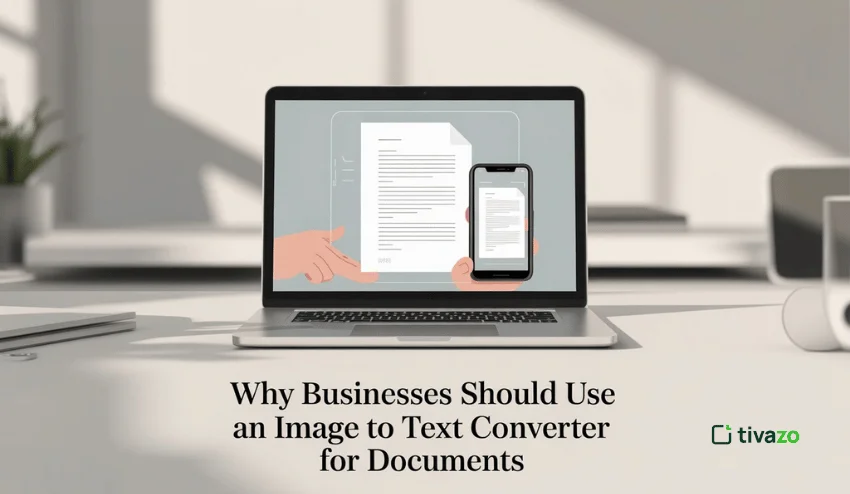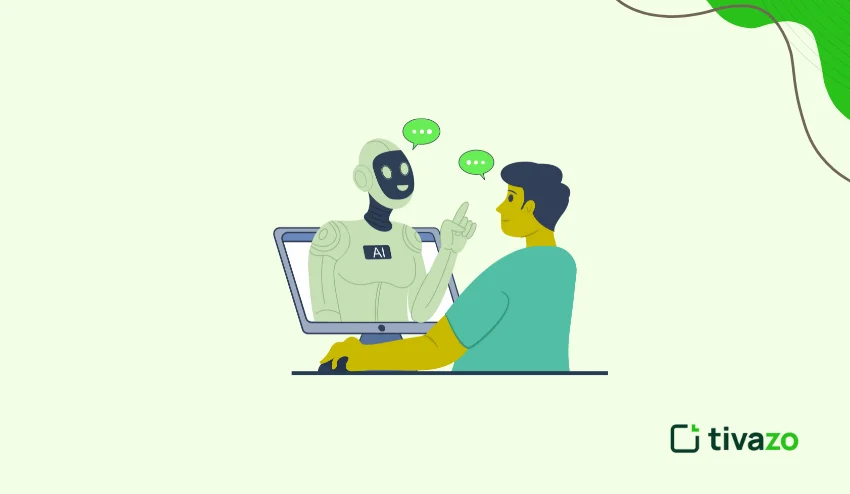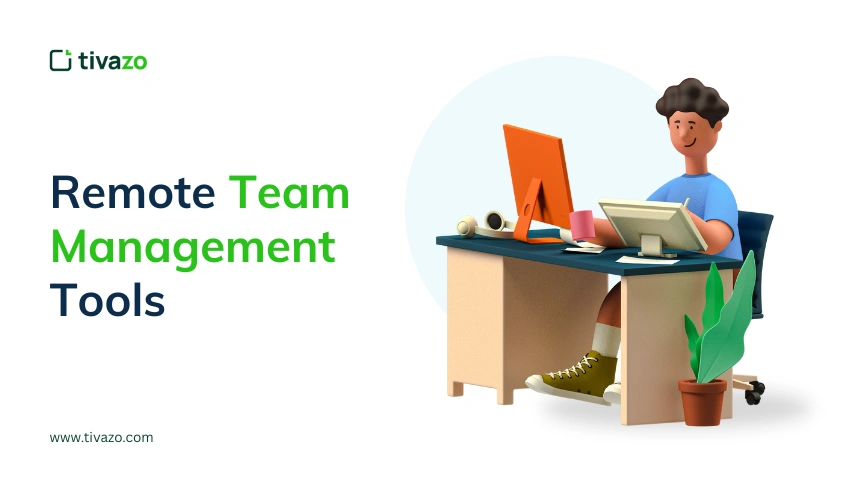Running any business requires dealing with an onslaught of documents, invoices, receipts, and handwritten notes. Most of these are stored as scanned documents or images. Images are easy to store compared to text files, but they are not editable.
According to IDC, approximately 90% of business data exists in unstructured form, making it difficult to manage data. When so much information is locked in unusable formats, this causes delays, greater costs, and error risks. Using manual methods for typing the information from scanned documents and images consumes much time and effort.
That is why businesses are turning to image-to-text converters to handle documents more effectively. These tools make document handling easier, accurate, and faster. In this blog, I’ll explain the key reasons why businesses should rely on such converters for their everyday work.
Why Using Image-to-Text Converters Matters in Business
The following are some of the main reasons why using image-to-text converters is becoming essential.
1. Saves Time and Resources
As already discussed, manually typing information from documents or reports can take hours. It is not a practical option for businesses that deal with a large volume of data. Image-to-text converters can improve this process. These help convert these images or scanned documents into editable text within seconds. It also reduces the need for additional staff and costs. As a result, businesses can save time and resources.
2. Improves Data Accessibility
Documents in digital text format make it easier to search and copy information from them.
For example, instead of searching through piles of paper to find a specific client’s payment details, an employee can use a quick search. Within seconds, they can find the information they need.
This makes the information more accessible. The employees will spend less time searching for information. It also helps businesses to respond to clients’ requests more effectively.
3. Minimizes Errors in Data Entry
When humans type data from images, errors tend to creep in. They may miss a word, spell something incorrectly, or skip a number. A small error in an invoice or report can result in a bad outcome. Image conversion tools like the Image-to-Text Converter can provide image data entry that is effective and help maximize accurate data entry, and minimize mistakes. This helps employees spend less time correcting or re-entering data. Positive effects of accurate data entry are that workflows improve, and businesses operate effectively and efficiently.
4. Supports Better Record Management
Businesses must also keep digital records for compliance and/or audit regulations. The files that are pictures or scanned documents cause a gap in the reliability of these important documents. This is where the Image-to-Text Converter can be used to efficiently extract the data present in the images and store it in organized digital archives that are easier to retrieve and can be backed up when needed. Having data in organized archives improves efficiency because it keeps important information always at hand.
As businesses grow, the volume of records will also increase. Having organized and stored documents digitally allows the documents not only to be stored and accounted for but also to be managed when needed. Organizing records in this manner improves record management for the business and mitigates the risk of lost documents and information.
5. Promotes Team Collaboration
In business, the teams often need to share information quickly. But if the documents are stored as scanned files or images, working on them becomes difficult. However, it can be made easier by converting these images into editable text files. The teams can easily collaborate using software like Google Docs.
In this way, multiple members can work on the same document simultaneously. This improves the workflow efficiency and reduces the delays because everyone has access to the latest information about the document that was converted into text. This helps avoid miscommunication and keeps the projects moving forward with fewer delays.
6. Increases Security and Compliance
Paper documents are usually difficult to protect. Over time, they are damaged or are easily misplaced or even lost in incidents like fire or flooding. By converting these documents into editable text, the businesses can store them on encrypted servers. These files can be protected with a password, and access can be controlled more effectively.
Industries like Healthcare, Finance, and Legal services require accurate and easily retrievable documentation. This can be achieved through the use of image-to-text converters. Additionally, storing documentation in a digitized fashion helps meet compliance standards with more resiliency while also providing secure access to critical information.
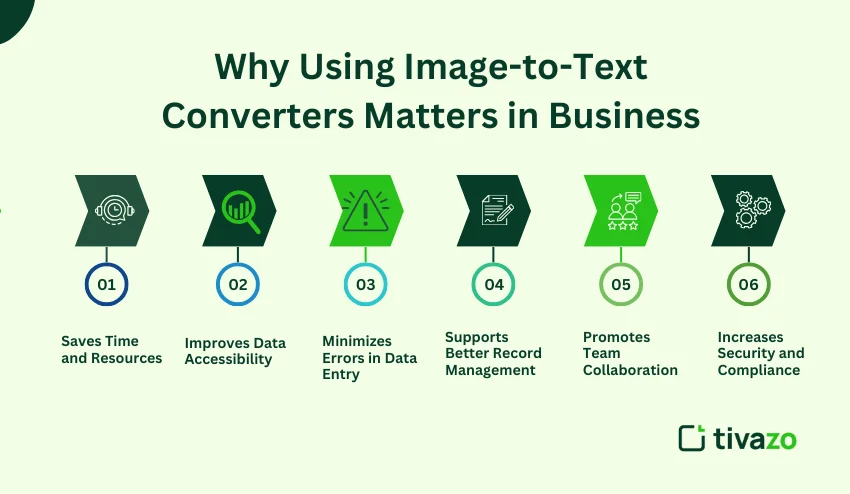
Real-World Example of Image to Text Conversion
Image-to-text converters are online tools that can convert the text within images into editable text in a few seconds. To understand how these converters work, let’s understand this through an example involving the use of Image to Text Converter, which I found quick and easy to use. Let’s insert a random image into this tool and check how it works
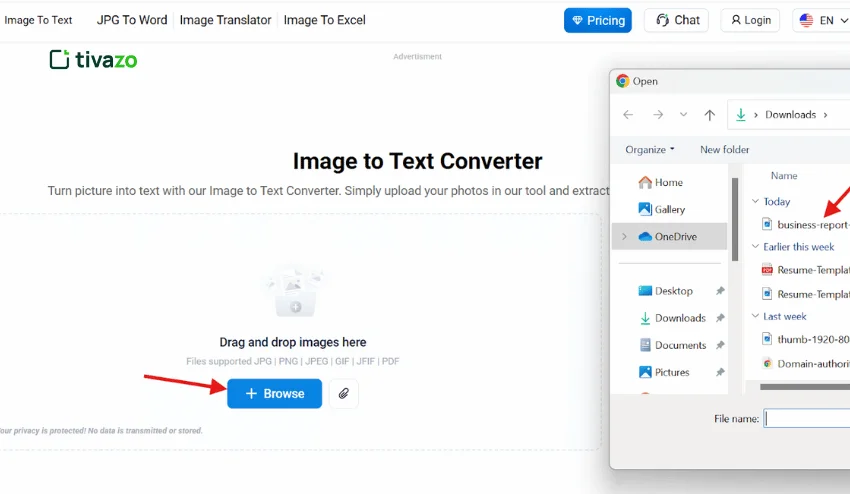
After that, simply click on the “Submit and Extract” button and allow the tool to continue converting the document.
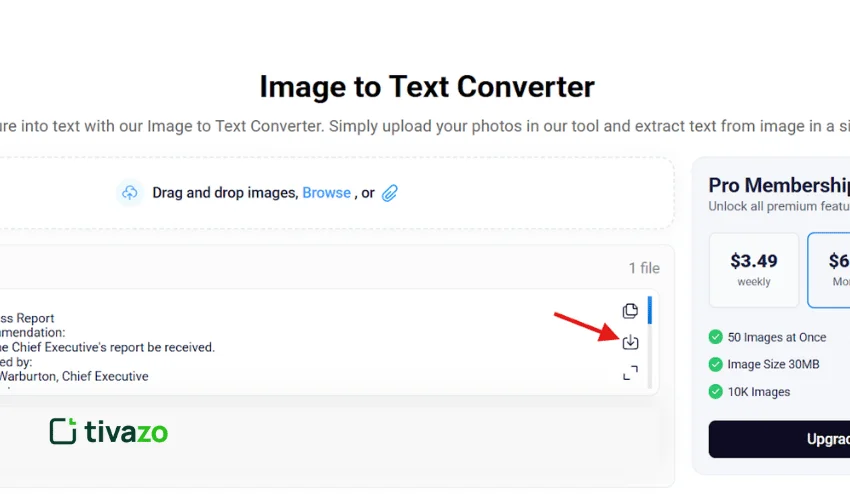
The tool takes a couple of seconds to offer the editable version of the text, as you can see in the screenshot above. It also gives the option to download this as a “TXT” file.
This is how one can convert an image into digital text. Most online converters follow similar steps. All you have to do is access a converter like I mentioned above and convert any of your images into text instantly.
The Reasons Businesses Should Use Image-to-Text Converters
To appreciate the real-world impact image-to-text converters can have on companies’ day-to-day operations, consider five additional ways they help an organization operate smarter and more effectively.
1. Increases Efficiency
Every business department, including finance, HR, marketing, and customer support, works with documents daily. Utilizing image-to-text conversions can eliminate a significant amount of repetitive work by digitizing scanned or handwritten documents into editable digital text. This frees employees up to have meaningful work done and to focus on cash flow, and spend less time typing.
Take, for instance:
- Finance can extract invoice numbers or transaction data.
- HR can digitize employee personnel records for easy reference.
- Marketing can convert screenshots or PDFs into editable text for content or campaign planning.
In general, automation enhances workflow, accelerates delivery, and enables more is more efficient teams.
2. Decreases Admin and Operational Expenses
- Hiring or outsourcing the work makes manual data entry both inefficient and expensive.
- Data entry, once transformed into images to be processed using an image-to-text converter, is automated so the work can be done quickly without a human.
- This reduces administrative overhead and allows teams to free up budget to direct toward growth, innovation, or upgrading technology.
- For small and medium-sized businesses, automation adds an efficient way to manage increasing data volumes without hiring more staff.
3. Facilitates Data Integration and Analysis
- After text is extracted from an image, it can be integrated into any application and advanced software, such as Excel, Google Sheets, or CRM software.
- This allows for analysis of trends from previously unstructured sales data or from handwritten notes from customer meetings.
- Having all of the information in digital, structured formats allows for improved decision-making and real-time analysis, both of which are very difficult with a manual process.
4. Promotes Sustainability and Paperless Transformation
Utilizing image-to-text supporting technology is also one of the most environmentally friendly steps you can take.
Less reliance on paper documents means less physical storage, less printing, and less waste overall.
Organizations can store and share their document files electronically, which also positively aligns with global sustainability goals and corporate social responsibility (CSR) values. For instance, when businesses upload files and generate QR codes, they can easily share digital versions instead of printing and distributing physical copies, further reducing paper waste.
5. Enhances Data Security and Compliance
- Various industries, including healthcare, finance, and law, require strict oversight in how any document is stored and accessed.
- While paper files can be easily misplaced or destroyed, having supplies for the file to be converted into customizable and encrypted electronic text allows a file to be stored more safely.
- Access to the file can only be granted to specific authorized users, keeping essential information confidential.
- Moreover, when there is no requirement to access paper files, compliant with governing regulations such as the GDPR or HIPAA, the trail of audit kept is increasingly apparent and concise, increasing reliable retrieval.
- Using technology to track and maintain secure documentation that is organized, businesses enhance trust in individuals providing documentation while keeping all operational practices visible for image-to-text.
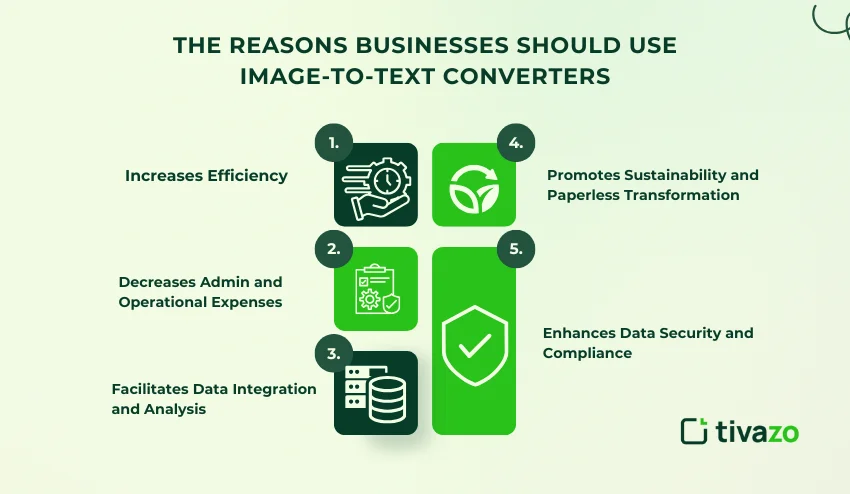
Conclusion
Accuracy and efficiency are both important for any business, and managing documents effectively plays a big role in achieving both of these. Image-to-text converters can help turn scanned files and images into editable and searchable text.
This makes the important information accessible and editable, saves time, and reduces errors. Also, the employees can better focus on more productive work instead of spending time on manually converting images.
Businesses can improve their record management with the help of this technology and even respond to client requests more effectively. Overall, Image-to-Text Converter for businesses can be a powerful step toward productivity and smoother operations.
